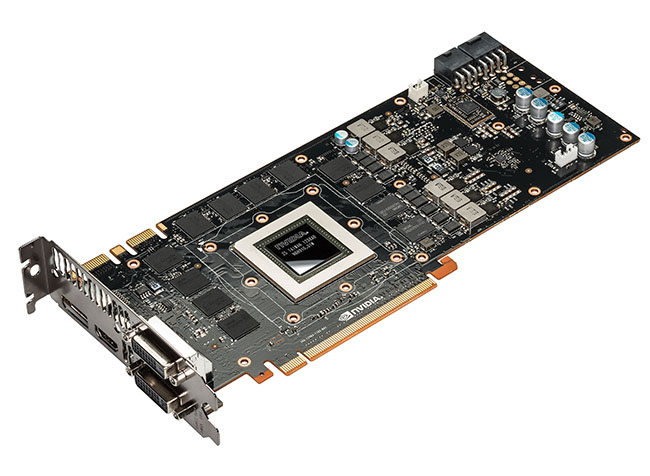GTX 780 pixellised
The similarities between GeForce GTX 780 and GTX Titan extend to industrial design, with Nvidia carrying over the beautifully engineered chassis and cooler assembly. There are no obvious differences other than the inscribed name on the left-hand side of the enclosed heatsink.
Measuring 10.5in from tip to toe and, going by empirical data derived from the Titan review, patently able to cool a reduced-core version of the range-topping GPU, Nvidia has made a sensible choice in not cheapening the premium look and feel of its best (and, currently, only) 7xx-series card.
We could write more on just how well put-together the cooler is, but it's probably best you take a look at the Titan piece for the sake of repetition. And configured with an identical TDP of 250W - Nvidia's probably playing it safe here - the standard 8+6-pin connectors remain intact. Heck, even techno-geeks would have a hard time telling it apart if you could scrub out the GTX 780 indent and replace it with Titan.
The better value-for-money proposition for GTX 780 makes it a better candidate for multi-GPU running, so just like its bigger brother, up to three can be tied together for stupid-good performance.
Outputs remain the same, as well, which means four concurrent displays without having to use any special adapters, a la AMD.
Yet cast your mind back to the first page and, in cheapening this card to hit the desired price point, Nvidia outfits it with 3GB of GDDR5 memory instead of 6GB. Titan uses a total of 24 chips to constitute the framebuffer - 12 on each side - and, as expected, while using the same PCB, Nvidia removes the dozen memory modules on the rear of the card.
The formula here is simple, because Nvidia is using cards that would ordinarily be made into Titans and repurposing them for the lower-cost, albeit similar GTX 780. There's nothing wrong with that at all, but it may mean that fewer Titans are produced for the ultra-enthusiasts for whom money is no concern, though not many should, or would, be willing to pay double for a card that, on paper, isn't much faster.
You can play a spot-the-difference game between the GTX 780 bare PCB and the Titan's. A virtual pat on the back if you managed to find more than a handful of changes.
In summary, GTX 780 3GB uses the same excellent heatsink and PCB as the similar Titan card. One inherent problem in providing top-class reference designs rests with add-in board (AIB) partners having great difficulty bettering it with their own non-standard models, leading to a lack of product differentiation in the market. This is more the AIB's problem than Nvidia's, mind.













